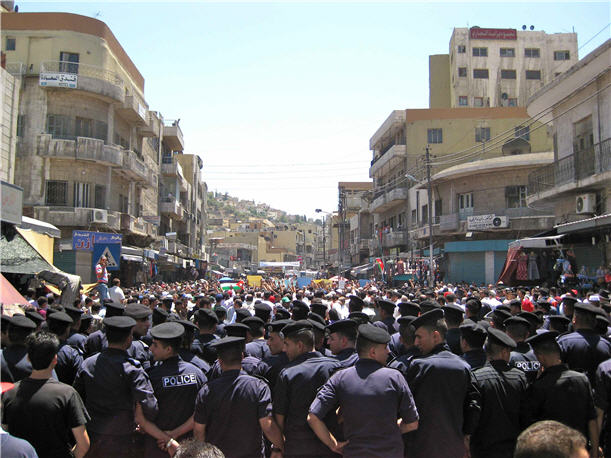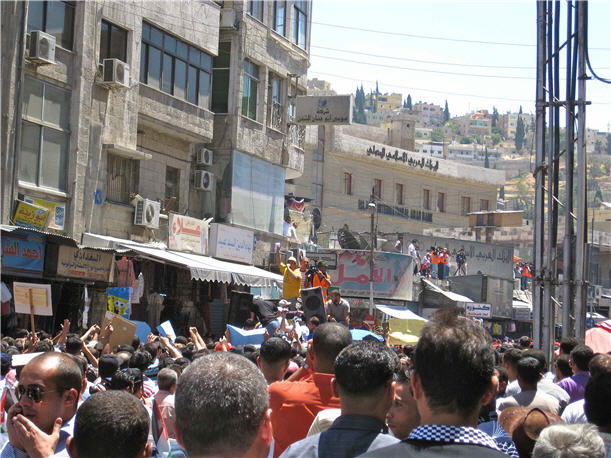http://www.fpri.org/enotes/2011/201107.helfont_helfont.jordan.html
Samuel Helfont is a Ph.D Candidate in Near Eastern Studies at Princeton University and an Associate Scholar of the Foreign Policy Research Institute. He is the author of Yusuf al-Qaradawi: Islam and Modernity (2009) and the FPRI monograph The Sunni Divide: Understanding Politics and Terrorism in the Arab Middle East.
Tally Helfont is a research fellow and Coordinator of FPRI’s Program on the Middle East. Her research focuses on strategic issues in the region and on radical Islamic movements. She has also instructed training courses on behalf of K3 Enterprises in Civil Information Management to U.S. Military Civil Affairs Units and Human Terrain Teams assigned to Iraq and Afghanistan.

Wasat al-Balad Demonstrations
No Arab state has been able to ignore the sweeping changes of the Arab Spring. It has dominated the Arab language news, and changed the perceptions of millions about what is politically possible. Yet in each society, the demands for change have manifested differently. In Egypt and Tunisia, the people were able to topple their respective regimes through peaceful protests. In Syria and Libya, the demonstrations have increasingly turned into bloody clashes and civil war. In Bahrain, what started as a call for reform, quickly spiraled into sectarian politics and culminated in violent confrontations. Caught between all of this is one of America’s staunchest allies in the region and one of only two Arab states to have officially made peace with Israel. The small, yet strategically located Hashemite Kingdom of Jordan is now teetering on the edge of the Arab Spring.
On Friday, July 15, around 2,000 Jordanians-youth activists and Islamists among them-gathered in downtown Amman to demand political reform. The protesters had planned for this to be the first open-ended sit-in since the March 24/25 protests in Amman’s Interior Circle that ended in bloodshed and disappointment. Though some 2,000 peaceful demonstrations have been held in Jordan since the beginning of the year, this open-ended protest, like its predecessor in March, was meant to be something more significant.
Even before the Friday noon prayer began, the atmosphere in the square adjacent to Amman’s Al-Husseini Mosque was tense. Under the oppressive Middle Eastern sun, several hundred Jordanian police officers and military personnel-wearing a diverse array of uniforms, berets, and unit patches-gathered, waiting for the demonstration to begin. The Friday sermon resonated over the loud speakers, while a few hawkers continued selling their wares. Residents and shoppers milled about, seeking refuge under what little shade they could find, and jockeying for an optimal vantage point to view the anticipated events. The streets leading up to the mosque square were lined with buses carrying additional security forces, flanked by dozens of empty “paddy wagons,” ready to cart off demonstrators in case events took a turn for the worse. Journalists, meanwhile, positioned themselves among the waiting populace, on top of buildings, and on balconies-their cameras trained on the entrance of the mosque and the street below. As the final call to prayer sounded, all-pre-demonstration activities were momentarily suspended as hundreds of men lined up shoulder-to-shoulder, removed their shoes, and bowed down in prayer. Some police were scattered among them, as the distinction between about-to-be-protestor and about-to-be-security was blurred.
As soon as the prayer ended, the rugs were hastily gathered and much of the crowd quickly disbursed. From the entrance of the mosque, a band of demonstrators emerged and surged forward. Its ranks swelled as those from the surrounding area joined in. They began their chants, as a ring of navy-blue uniformed security personnel formed a human chain around the gathering protestors. The crowd was comprised of mostly men, though a small contingent of 20 veiled women joined at the back of the procession, holding signs and Jordanian flags. They started making their way down the street towards al Nakheel Square. Several young, idealistic looking activists in a truck laden with speakers, took the lead. A young man on the truck, wielding his microphone enthusiastically, shouted slogans over the loudspeaker, and soon the sea of protesters following him joined: “The People Want Reform of the System,” “The People Want Elected Government,” “Peaceful, Peaceful,” “We Are With the Police and the Army,” and so on. [1]
These calls for peaceful reform-as opposed to revolution or overthrowing of the regime-did little to limit the regime’s reaction. A special unit of military police, with their distinctive red berets, formed a line in the street preventing the protesters from reaching their destination. As the protesters met the line of security forces, pushes and shoves turned quickly to blows with batons as uniformed officers and riot police attacked the crowd. Around fifty pro-government protestors and so-called “loyalists,” who were positioned on the opposite side of the red berets, also began physically attacking the protestors, with the police officers and riot police caught in the middle. Almost two-dozen people were beaten, including nine journalists. This was despite the fact that members of the press were wearing the specially labeled orange vests that public security had given them to ensure their protection. [2] Once the violence subsided and the wounded were carted off, some protestors were able to make their way to the square, but their numbers and their enthusiasm were greatly depleted.
Jordan’s young and well-educated population seems ripe for the message of the Arab Spring. The country has serious economic troubles, endemic corruption, and a clear lack of political freedom. Thus, it was not surprising that uprisings in Egypt and Tunisia quickly spread to Jordan. The protests on the streets of Amman have culminated in violent confrontations at the end of March and now again in July. Thus far there has been one reported death and a slew of injuries.
The government has tried to undermine the protests by giving the demonstrators the political space to vent their frustrations, and presenting the regime as more tolerant than Mubarak’s Egypt or Assad’s Syria. At the same time, the regime has used force against demonstrators to establish certain red lines pertaining to critiques of the monarchy or attempts to establish a prolonged demonstration. As such, the regime has increasingly resorted to Orwelian language in its efforts to both appear tolerant and to dissuade protests. For example, the state-controlled Jordan Times ran a headline on Thursday before the protests that read: “Government firm on banning open sit-ins, urges a more peaceful approach.” [3] Yet it is unclear what activity would be more peaceful than a non-violent sit-in.
Thus far, the government approach has been successful in limiting the protests’ momentum. And now as the summer heats up and the world remains fixated on the events in the Arab world, Jordan’s reform movement is attempting to regroup and assert itself on what sometimes seems to be a reluctant population. Indeed, most Jordanians have yet to fully embrace the idea of an Arab Spring in their country and Jordan has yet to experience demonstrations comparable in terms of either size or vigor to those in Egypt, Syria, or Libya. There have been no open calls for overthrowing the monarchy and almost everyone agrees on the need to avoid the chaos that has accompanied the uprisings in neighboring countries.
One might offer several theories on why the Jordanian Spring has been so temperate. The lack of political freedom in Jordan is clear, but it is nowhere near the level of repression that Syrians and Egyptians have experienced. Furthermore, there is a deep conflict simmering just below the surface of Jordanian society. Jordanians of Palestinian origin constitute the majority of the population, yet ever since Yasser Arafat and the PLO tried to overthrow the regime during the 1970 events that became known as Black September, Jordanians of Palestinian origin have been mostly kept out of political power. Most of the population understands that clashes between Palestinians and Jordanians are not unlikely if the political situation deteriorates. But no one wants a civil war, and at times, it appears the only thing holding the small country together is the monarchy. Activists have thus limited their demands to reform of the system and the implementation of a true constitutional monarchy. Yet even these calls have failed to gain much traction, as Jordanian elites have dug in to protect their privileges.
Nevertheless, the prospect of Jordan’s protests turning into a real force for change remains real as long as the activists continue to be committed and the population’s demands for reform go unanswered. If the protests gain traction, another staunch American ally in the Middle East could come under severe pressure to change its stance toward the West, and toward Israel. Thus far, neither the regime nor its critics have backed down and Jordan hangs in the balance.

Notes
- [Text] For coverage of the demonstrations, see: “Black Day,” Al-Ghad (Jordan), July 15, 2011 [Arabic] www.alghad.com/index.php/afkar_wamawaqef/article/26285.html?sd=0 ; “Jordan: The Most Violent Scenes of The Suppression of the Jordanian Security Mutasim July 15” Jordan News Network, www.youtube.com/watch?v=jkNRrZKYMOA&feature=player_embedded&has_verified=1
- [Text] For the announcement of these protective measures, see: Taylor Luck, “Measures to Protect Journalists Announced,” The Jordan Times, July 15, 2011 www.jordantimes.com/?news=39485
- [Text] “Gov’t Firm on Banning Open Sit-Ins, Urges a More Peaceful Approach,” The Jordan Times, July 17, 2011. www.jordantimes.com/index.php?news=39452









